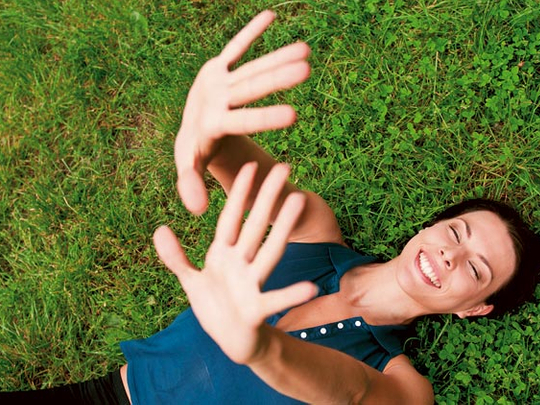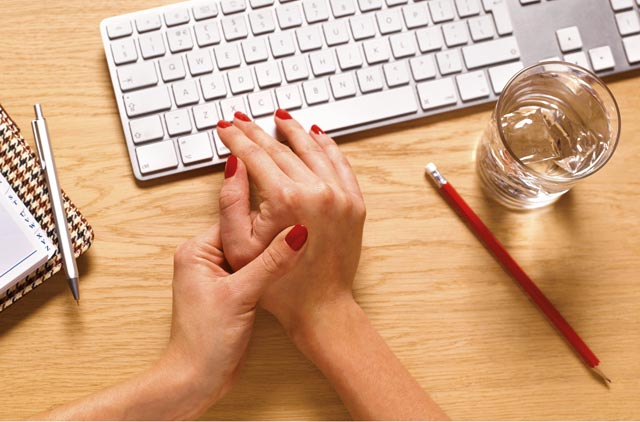
Think of a typical arthritis sufferer and you usually picture someone in old age, not an elite athlete like Paula Radcliffe. But the marathon runner is proof that the condition blights younger people’s lives too, as osteoarthritis forced the 38-year-old world record holder out of the Olympics.
A recent report by the UK-based charity Arthritis Care found that while the average age of osteoarthritis (OA) diagnosis is 57, as many as one in five people under the age of 45 are found to have the problem, and approximately 27,000 people living with arthritis in the UK are under the age of 25.
A major factor in Radcliffe’s condition was the repetitive foot stress caused by long-distance running, and she has described the joint in her left foot as “degenerative and badly damaged”.
Consultant rheumatologist, Professor Simon Bowman, explains that athletes like Radcliffe develop OA for different reasons than non-athletes. “Although we call OA ‘wear-and-tear arthritis’, for most people it isn’t necessarily related to the activities they’ve done,” he says. “But athletes are putting so much stress on their joints, so someone like Paula would be more prone to these kinds of problems.” However, as the Arthritis Care research shows, you don’t have to be an athlete or elderly to get OA.
Emirates Arthritis Foundation (EAF) figures show that arthritis affects 20 per cent of the UAE population, but only 6,000 people have been officially diagnosed – the low figures can be attributed to low awareness of the condition’s prevalence, as well as a lack of specialists in fields such as rheumatology in the UAE.
Suffering from arthritis can have a huge impact on your quality of life. The OANation 2012 survey found that 71 per cent of people with OA are in constant pain, and one in eight (more than a million people) say that pain is often “unbearable”.
World Arthritis Day, held every October 12, aims to raise awareness of the issues affecting those with OA and all forms of arthritis, and to teach sufferers the steps they can take to improve their condition – which include having a good laugh...
What is it?
OA is a chronic condition characterised by the breakdown of the joint’s cartilage, which causes the bones to rub against each other, leading to pain, says Dr Asha Jones, Ayurvedic consultant at the Dubai Herbal and Treatment Centre. It can occur in any joint, but it most commonly affects the hands, feet, spine, and large weight-bearing joints like the hips and knees.
There are two types of OA: primary osteoarthritis, which is associated with ageing of the joint, and secondary osteoarthritis, which is caused by another disease or condition such as obesity, repeated trauma or surgery to the joint structures, abnormal joints at birth or diabetes.
Although many of the symptoms can be similar, OA shouldn’t be confused with rheumatoid arthritis (RA), a chronic, inflammatory autoimmune disease that occurs when the body’s own immune system mistakenly attacks healthy cells. This condition is unrelated to age and can affect multiple joints and organs.
Pain and stiffness are the most common symptoms of OA, says Dr Abdulameer Rasheed, specialist rheumatologist at Canadian Specialist Hospital, Dubai.
Sometimes extra bone can be formed round the joints, further restricting normal movement. There may also be secondary inflammation, causing swelling.
But OA is much more complex than just simple wear and tear, and has both environmental and genetic causes. Dr Rasheed, who treats four to five patients with arthritis per day, says the main causes of osteoarthritis are hereditary factors, overuse of joints, injury and obesity.
Arthritis Research UK estimates that inherited genetic factors represent half of the risk of developing the condition. In fact, a study funded by the organisation identified eight new genetic regions linked to the disease, in areas involving cell maintenance, cartilage regulation, bone development and body weight.
The study’s principal investigator John Loughlin, professor of musculoskeletal research at Newcastle University, says, “We know that osteoarthritis runs in families and that this is due to the genes that people pass on, rather than their shared environment.
“We were able to say which genetic regions are the major risk factors for developing osteoarthritis – the first time that this has been possible for this common yet complex disease.” It’s hoped the findings could eventually help researchers develop drugs to cure arthritis.
Growing problem
While OA is becoming more common for all ages, the main risk factors for developing the disease are being overweight and over the age of 50. “While there’s nothing we can do about ageing, we can manage our diet and weight and minimise the stress on our joints,” says Judith Brodie, chief executive of Arthritis Care.
“Sedentary lifestyles are not good for anyone who wants to lead a healthy life, including people suffering from arthritis,” says Dr Rasheed. “Long working hours on the computer, or lack of physical activity are some of the major causes for some forms of arthritis.”
Dr Jones agrees. “Movement and activity circulates joint fluid and promotes cartilage health and bone strength. Sitting with poor posture for more than four hours daily can lead to degenerative back conditions because more stress is placed on the intervertebral discs and the facet joints, which leads to osteoarthritis and spinal stenosis.”
The OANation report found that 52 per cent of people with OA had reduced or given up walking completely since being diagnosed, and 44 per cent said they did no exercise at all. Yet 87 per cent of those who exercised said they felt the benefit.
“There’s evidence that exercise delays the onset of osteoarthritis,” stresses Brodie. “If you’re in pain, that first step can be difficult, but it’s worth it – if you get moving and keep moving, it can make a big difference.”
How to cope
The treatment of arthritis depends on the specific cause and is mainly aimed at controlling a patient’s symptoms and preventing joint damage, while maintaining the patient’s quality of life and ability to function, says Dr Rasheed. Current treatments only relieve OA symptoms, and medication is usually painkillers and anti-inflammatory tablets. Physiotherapy, chiropractic and osteopathy can also help, while joint replacement surgery is a last resort.
One new and unconventional way of managing the discomfort of arthritis is through group laughter therapy. “Laughter wellness exercises can minimise the impact of arthritis on sufferers’ everyday lives,” says Sahar Moussly, author, master behavioural coach and laughter wellness teacher. “Endorphins released as a result of hearty laughter exercises over an extended period can help reduce the intensity of pain in those suffering from arthritis, spondylitis and muscular spasms of the body.
“The release of these beta endorphins also causes the adrenal glands to manufacture cortisol, which is a natural anti-inflammatory and is brilliant for arthritis. It was medically proven that 15 minutes of laughter can give patients an extra two hours of pain-free sleep.”
Lifestyle changes can also make a huge difference, both to the chances of developing the condition and the suffering that occurs if it’s already started, so losing weight, exercising more and eating a healthy diet can really help. “Engaging in physical activity has many positive effects,” says Dr Rasheed. “Exercising helps patients sleep better, reduce body weight and, in some cases, reduce pain.
“Most arthritis patients tend to fall into a sedentary lifestyle due to pain and sometimes this may lead to the pain increasing. It is imperative that they check with doctors on the kind of exercise they should do and to what extent they can exert themselves. This really depends on each case and the severity of OA,” says Dr Rasheed.
For people worried about causing additional damage to joints, opting for low-impact exercise, such as swimming, walking and aqua aerobics, will still give you the benefits of a workout without straining joints. In addition, strict diet restrictions, physical exercises and yoga are helpful in aiding the recovery process.
“If people make the right lifestyle changes you can certainly see stabilisation of the condition, and in some situations there is evidence of the damage healing,” says Prof Bowman.
“That should encourage people, particularly those with osteoarthritis in their knees, which is closely related to obesity, to make big changes to their lifestyle so they can avoid the need for invasive surgery, which would make a big difference to their final outcome.”
Five ways to stop arthritis slowing you down
There are simple steps you can take to protect your joints, reduce discomfort, and improve mobility, starting today. Here are five of them:
1. Keep moving. Avoid holding one position for too long. When working at a desk, for example, get up and stretch every 15 minutes. Do the same while sitting at home reading or watching television.
2. Discover your strength and use it effectively. Put your strongest joints and muscles to work. To protect finger and wrist joints, push open heavy doors with the side of your arm or shoulder. To reduce hip or knee stress on stairs, let the strong leg lead going up and the weaker leg lead going down.
3. Plan ahead. Simplify and organise your routines so you minimise movements that are difficult or painful.Keep items you need for cooking, cleaning, or hobbies near where they are needed (even if that means multiple sets of cleaning supplies, one for your kitchen and one for your bathroom, for example).
4. Take advantage of labour-saving devices and adaptive aids. Simple gadgets and devices can make it easier to perform daily activities such as cooking, gardening, or even getting dressed. For example, long-handled grippers are designed to grasp and retrieve out-of-reach objects. Rubber grips can help you get a better handle on taps, pens, toothbrushes, and silverware. Pharmacies, medical supply stores, and online vendors stock a variety of aids for people with arthritis.
5. Arthritis sufferers often worry about becoming dependent on others, but only a very small percentage of people with arthritis become severely disabled. Educate family members and friends about how arthritis affects you, and don’t be afraid to ask for help.
Information courtesy of Harvard Medical School












